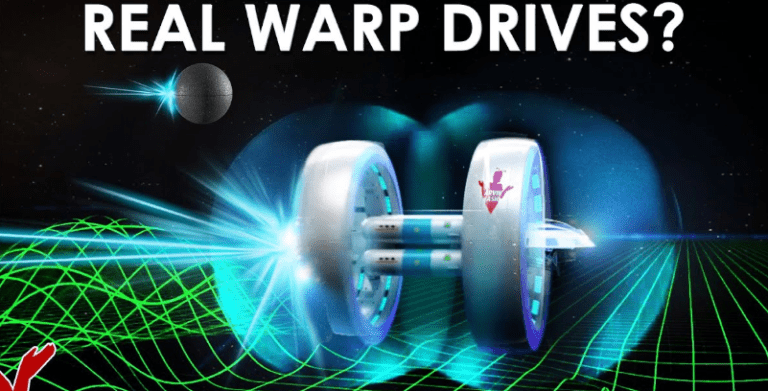REAL Warp Drives? NEW research proposes a solution!
What Is Warp drive ?
A warp drive is a fictional superluminal spacecraft propulsion system in many science fiction works, most notably Star Trek, and a subject of ongoing physics research. A spacecraft equipped with a warp drive may travel at speeds greater than that of light by many orders of magnitude. In contrast to some other fictitious faster-than-light technologies such as a jump drive, the warp drive does not permit instantaneous travel and transfers between two points, but rather involves a measurable passage of time which is pertinent to the concept. In contrast to hyperspace, spacecraft at warp velocity would continue to interact with objects in “normal space”. The general concept of “warp drive” was introduced by John W. Campbell in his 1957 novel Islands of Space.
Einstein’s theory of special relativity states that speed of light travel is impossible for material objects that, unlike photons, have a non-zero rest mass. The problem of a material object exceeding light speed is that an infinite amount of kinetic energy would be required to travel at exactly the speed of light. Warp drives serve to circumvent this limitation in fiction to facilitate stories set at galactic scales.
Two new recently published, peer-reviewed scientific papers show that real warp drive designs based on real physics may be possible. They are realistic and physical, which had not been the case in the past. In a paper published in 1994, Mexican physicist Miguel Alcubierre showed theoretically that an FTL warp drive could work within the laws of physics. But it would require huge amounts of negative mass or energy. Such a thing is not known to exist.
In a recent paper published by Applied Physics, authors Alexey Bobrick and Gianni Martire, outline how a physically feasible warp drive could in principle, work, without the need for negative energy. I spoke to them. They had technical input on this video. What Alcubierre did in his paper is figure out a shape that he believed spacetime needed to have in order for a ship to travel faster than light. Then he solved Einstein’s equation for general relativity to determine the matter and energy he would need to generate the desired curvature. It could only work with negative energy. This is mathematically consistent, but meaningless because negative mass is not known to exist. Negative mass is not the same as anti-matter. Antimatter has positive energy and mass. Even if you could create the Alcubierre curvature, you still need to accelerate the ship to speed of light and beyond. But to go beyond C, you have to have superluminal matter, or infinite energy. This is not possible. What Bobrick and Martire figured out is that there is more than one type of warp drive. We can get to Proxima Centauri in 10 months without going faster than light, by dilating time inside the ship. If a spaceship is constructed of a massive super dense material, close to the mass density of a neutron star, then any individuals inside this ship would experience significant time dilation. Passengers on such a ship could go to Proxima Centauri in about 9 earth years traveling at half the speed of light, but only about 10 months would have passed from their perspective. But a huge amount of mass would still be needed, on the order of about the mass of Jupiter or larger. And you would still need some kind of momentum exchange, similar to a rocket to accelerate this ship. Accelerating such a massive ship to half the speed of light would require the energy equivalent of 13% of its mass. Fusion technology or accretion disk energy could be used. In a 2021 paper by physicist Erik Lentz of Gottingen University, he shows that unlike the solution by Alcubierre, which required unphysical negative energy, no negative energy is required to create certain shapes of warp bubble that could travel at any speed. The soliton he calculated looks nothing like the Alcubierre soliton, but it requires no negative energy. And it could theoretically travel at any speed, including traveling faster than the speed of light. Lentz does not think that the speed of light is necessarily unbreakable for his soliton. But in any case, it would require quite a lot of mass, at least an amount equal to 1/10th that of the sun. Many other challenges would remain, but the point being made in these papers is important because it shows that interstellar trips are theoretically and physically feasible.
More research can reveal optimizations on how to make the drive more efficient. We can start creating tiny warp drives in a lab, and look for microscopic warp effects as a proof of concept. A lot of work also needs to be done in material science and in constructing and developing new efficient propulsion systems. But if it is possible, then humans will undoubtedly figure out a way to do it. It is just a matter of time.
Reference papers:
Lentz: Clik Here
Bobrick & Martire: Click Here
Do not forget to share your opinion with us to provide you with the best posts !




0 Comments